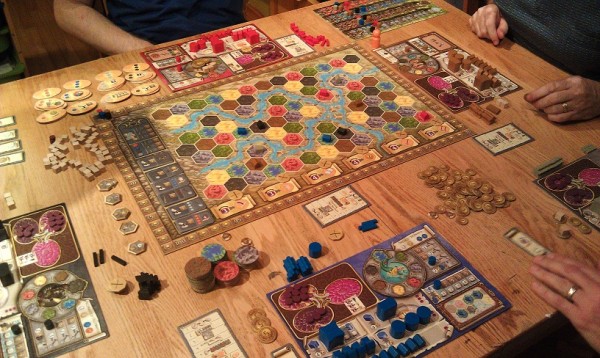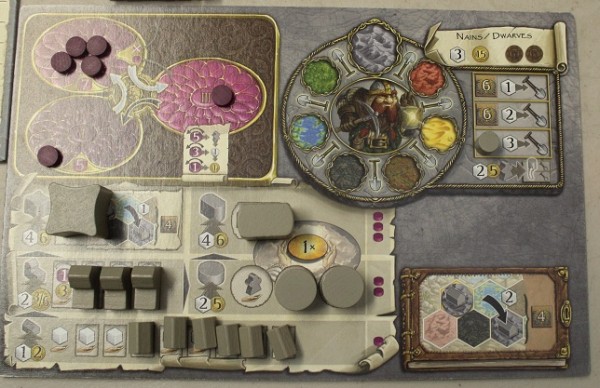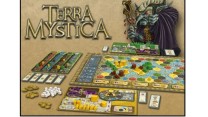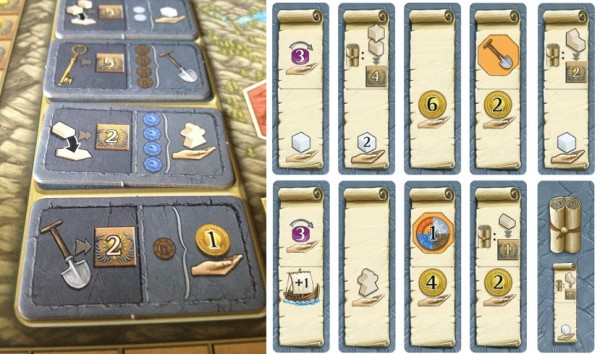Terra Mystica is a fantasy-themed, area-control Eurogame, released in late 2012 to much anticipation after a very successful stint at Essen 2012. Only recently has the game been readily available due to impressively high demand. It features plenty of deep strategy within every turn, and many unique races, giving it a great deal of replayability.
I still remember the first time I pulled (well, heaved) out the Terra Mystica box in front of three of my friends, hoping to drag them into a world of clashing races attempting to build and grow in a realm far too small and uninhabitable, forcing them to compete for space, for money, for magic spells and praise from the Gods. Unfortunately, they could do nothing but watch in abject horror as I pulled bag after bag of wooden pieces and cardboard tokens, double-sided player boards, and a million chits out of the box, dropping them unceremoniously onto the table, watching their eyes grow wider and their appetite for a heavy Eurogame waning by the second. Fortunately, one epic rules-reading session later, they were back on-board, excited to play and ready to go.

In Terra Mystica, you play one out of a choice of fourteen fantasy races, attempting to build and upgrade buildings, create cities and gain magical power, in pursuit of accumulating the most victory points through creating the largest collection of buildings and upgrading positions on the four individual cult tracks.
The game is split into six rounds. Each round is further split into turns. On your turn, you can take one, and only one of eight actions. After you have completed that action, the next player takes their turn, and so on. Once you have decided you wish to stop, or you cannot do anything else, you pass, and will take no further part in that round. Once everyone has passed, there’s a short cleanup phase, then the next round starts.

This is the player mat for the Dwarves. Each race has its own unique board and attributes. You have different starting resources and income, two completely unique abilities, and the costs for certain upgrades will vary; all of which gives the game fantastic replayability. The boards are double-sided, sporting a different race (but same colour) on each side. The bulk of the board is taken up by your buildings: Dwellings, Trading posts, temples, a sanctuary and a stronghold.
As you build dwellings on the board (bottom row), you’ll expose more of the icons of a cube with a hand symbol underneath. The hand indicates it is starting income which you will obtain at the start of every new round. You can then upgrade a dwelling to a trading post, which will give you a different income: 1 magic power and 3 gold. However, the dwelling you upgraded goes back on your player board, so you will also acquire one less worker cube, which makes this a very strong balancing act between having presence on the board and maintaining a steady flow of resources. You can then upgrade your trading posts to either temples (which give you 1 priest every round) or strongholds (which lets you access one of your race-specific abilities.)
The other eye-catching feature on the player board is the big wheel in the centre. Every race has a ‘home terrain’ (For Dwarves, this is mountain) and they can only build on this terrain. If they wish to build on other terrain, they need to terraform that land into their home terrain using this wheel. Every step away from your home terrain costs an extra ‘shovel’ which is paid for using workers or magic. So for Dwarves, they can quite easily terraform forests and red wasteland into mountains, but swamps and plains are very expensive. This will have an effect on where you start on the main board but also where you plan to expand.
Finally, you have your magic which is represented by these three ‘bowls of power’ (I swear this is what the rulebook calls them). The bowls are labelled 1 – 3, and you’ll start with a varying number of purple power tokens in bowls 1 and 2. As you gain power, you don’t add purple tokens to the bowls, they simply move. All of your tokens will move from bowl 1 to 2. Once bowl 1 is empty, your tokens will move from bowl 2 to 3. Once you have tokens in bowl 3, you can spend them to take actions labelled on the bottom of the main board, or convert the tokens into additional priests, workers or money. Those tokens then move from bowl 3 to 1, and you then have to empty bowl 1 again when you gain power. It’s a pretty convoluted way of ensuring that magic has some kind of time lapse and is something you have to steadily acquire and use sparingly, rather than just blow your load all in one go.
And now your next question (after ‘Can you repeat all of this please?’) is ‘How do you gain power?’, and this is quite a fascinating concept.
There are a few ways of gaining power: You are rewarded power as income from trading posts and as you move up the cult tracks (more on that later), but the main way is from building and upgrading. Not from your buildings though, from your opponents.
Every time an opponent builds or upgrades a building that is adjacent to one or more of yours, you have the choice to gain power points equal to the value of your buildings (PP), and lose PP-1 Victory Points, which is such a fantastic idea. This is a game where expanding and growing is required for you to win, and to do that, you need plenty of space, but if you don’t build near other players, you won’t benefit from gaining all that lovely magical power, so you have to balance building near other players to benefit from this ability with making sure you have enough space to grow one huge unimpeded city. This is what makes this game work with fewer players as you’ll still be forced to compete for similar areas together.


The cult tracks are another feature you will need to focus on if you plan on winning. As you acquire priests as income, you can send them away to one of the cults (Fire, Air, Water and… uh, Jam. No, wait, Earth!) and move your token up that track. Doing so may gain you power, but you won’t score any victory points until the end of the game, with those gained based on which position you finish in for each separate track. Once you’ve placed a priest there, you don’t ever get it back, but there are only four spots for each track, so there can be a rush to grab the spaces.
Remember I said that a game is split into six rounds? Well, on each of those rounds, there will be a ‘round bonus’ which is randomly selected for each game, and will give you points if you do that specific action on that round. For example, you might gain victory points every time you upgrade to a trading post, or every time you found a city, or terraform a hex. This means that the game almost encourages you to do its bidding, and you can find yourself in a mad rush to upgrade things just because the game tells you to. The first time I played, I thought to myself, ‘Pfft, it’s only 3 measly points’, but take this bonus multiple times in a round, for multiple rounds, and it soon adds up! (I lost by a lot that game).
Towns are created when you build four adjacent buildings which have a collective value of 7 or more, and grants you… What’s that? MORE TILES! These ones give you victory points, coins, workers, whatever you like. They also give you a key, which allows you to access the highest point of each cult track.
You also need to consider the bonus tiles (above right), which you gain a new one of every round, and they grant you income or one-time-use special actions. The person that passes first in a round gets dibs on the bonus tiles, so you may decide to pass early to ensure you get the one you need, or perhaps another player has that specific tile, so you need to spend more time doing actions until that player passes so you can grab the tile for yourself, but this will put you down the player order for the next round.
At the end of the game, players are awarded victory points for the most buildings in one contiguous area and for their positions in each of the four cult tracks, and then whoever has the most victory points wins, and should scream, ‘YES!’ at the top of his or her lungs while simultaneously flipping the table and making the other players play 4,584-piece pick-up.
So, what do I think about the game?
Aesthetics – This game is frigg’n beautiful. All the wooden pieces and artwork are lovely, and the map is just this great big gorgeous coloured hexagonal lump of loveliness. This is a tree in a box: It has so many pieces and bits to play with, and it all looks fantastic. The rulebook is 20 pages of ‘Oh God Oh God Oh God’ but it has tons of diagrams and examples to help explain the many, many concepts.
Theme – The theme of this game is very much tacked-on. Instead of fantasy races, you could have made this a space theme with terraforming planets, or some kind of war setting. If you can instantly switch the theme like that, then it isn’t well-bonded. I like the races and their different abilities, the way they have their own varying home terrain, but really, this game could have been about anything.
Gameplay – I really love the gameplay that Terra Mystica provides. The replayability from the varying races is excellent, and you have so many different things you have to keep in mind at the same time. This is a heavy Eurogame. You’ll be planning quite a few turns ahead, counting and re-counting resources, hoping that the magic ability you need is still there and hoping the opponent near you gives you more magic power and doesn’t terraform a space you need. You’ll end up spending a lot of the time observing other players, figuring out what they’re planning and trying to find ways around that, and I love that it’s so deep and involved that way. You’ll be thinking pretty hard about some of the most basic stuff, like when you should pass (First person to pass goes first in the next round) and in which order to do actions. It is always very tense as you come to the close of the 5th and 6th rounds.
You get victory points for a lot of things, in fact, most things will give you some kind of bonus, so it’s not always clear which is the best strategy, and I think I’ve figured out that the best strategy in this game is to do everything. In Agricola, you win by doing a little bit of everything, and it’s similar in Terra Mystica, but instead you have to do a lot of everything. If you just flat out decide not to bother with the round bonuses to focus on building cities, or ignore the cult tracks and focus on round bonuses, you will lose many more times than you will win.
The board itself is a fixed board, so the terrain layout will be the same every game, which I feel is a shame, as it would have made every game very unique. The fact that you can get guides which tell you the best starting positions for every race is testament to the fact that this should have been randomised somehow.
I like the bowls of power (not the name though), but there is the ability to move tokens from bowl 2 to bowl 3 and then remove the same number of tokens out of the game completely, which garners magic you can use instantly, and reduces the number of tokens you need to move around the bowls. I’m not sure if I like this ability, as it means you can access the magic from the very start (which defies the point of having multiple bowls) but also means you can cycle tokens round the bowls more quickly.
Taking all of this into account though, I have to say that I absolutely love this game. If you’re a fan of Eurogames and want to spend a couple of hours analysing everyone’s turns, planning ahead, and watching your plans come to fruition, you will love this game, and will spend plenty of time after each session going back and figuring out how you could have improved, and more importantly, will want to play the game again.
There is currently an unnamed expansion in the works with six new races, six new player and main boards and some new mechanics, which while definitely isn’t necessary, as it will take you quite a while to master the base game, is certainly a welcome addition. You can check out the progress on the expansion with regular updates from the designers over on BoardGameGeek
Review by Mark Carter.
Roll 6 or Die is where we at Press X or Die share our love for other forms of gaming: card and board. Here you’ll find news, reviews and opinions along with other related articles.

